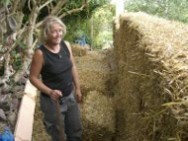
Lesley from Amazon Nails For the first time in a UK government funded project, Straw council houses (local government housing) are being built in Lincolnshire to cut costs and energy consumption.
The six three-bed semis in the village of Martin will each be made of 500 bales and cost GBP60,000 ($87,000).
‘It is the first time this has been tried in the UK,’ says North Kesteven District Council’s Tory leader, Marion Brighton.
‘The properties will look like conventional council houses except that the outer walls will be whitewashed rather than red brick. We have a lot of straw in this area, so it makes good sense to use it.’
The properties have been designed by eco-specialists Amazon Nails, a group of women architects and builders from Hebden Bridge.
The company has been involved in the construction of more than 50 houses throughout the UK and one, a property in Wales commissioned by a private client, was named the Grand Designs Eco-Home of the Year 2008.
Amazonails’ Barbara Jones said the straw homes have an expected life-span of 200 years.
She added: “Straw is incredibly strong and will support the roof and windows without the need for a metal or wooden frame.
“Straw homes do not need heating if they are properly designed.
“The bales trap a lot of air and it is the air which provides the insulation.”
Planning applications for two semi-detached homes in West Grove, Martin, and another two in Waddington, are due to be decided in March with the intention of starting construction of the first pair in late spring/early summer.
Locally sourced materials and labour will be used, with contractors A Hatcher and Sons, of Sleaford, named as the preferred choice.
NKDC has set a budget of £110,000 per home – about £20,000 less than a traditional brick-built property of the same size and design.
They will be indistinguishable from traditionally-constructed homes, with the straw walls plastered in lime and the use of conventional windows and roofs.
Although the properties will not need heating systems, wood-burning stoves will be installed to stave off very cold weather – and residents can rest assured in the knowledge that the fire hazard in a straw house is actually less than that for a conventional home.
NKDC also anticipates the homes to be carbon-neutral.
Mick Gadd, NKDC property services manager, said: “There will be a carbon footprint from the construction but I would expect that to be offset once people start living in them.”
Members of the public will have the opportunity to watch the building work in progress from a specially-constructed observation platform once construction has begun.
Environment Trust chief executive Jon Aldenton adds: ‘The bales are sustainable and provide excellent insulation, which cuts down on energy bills – extremely important in the current climate.’
8 Responses
I read that these have been completed. I wonder if any more are in the pipeline. It’s rare to see planning departments get something right!
My experience with straw bale insulation is mixed.
Before I went to dry compressed peat in heavy poly bags, I tried oat straw, obtained from the local feed and seed store. The bales fit nicely in poly rash bags. I used to bags for each bale. I first put the bale in one bag then slipped the second bag over the open end to make a somewhat sealed unit.
The straw still absorbed moisture and soon began to rot and I had a rodent problem from the little critters searching out the residual grains of oats that remained and they rather seem to enjoy using the bales as multi-family housing.
Straw will wok, but it takes a bit of forethought to get it right and it won’t work well in very wet climes.
Better take a straw poll on that Barry, ho ho ho.!
What I love about this is that they will actually cost less!
How cool is that? So often our govs. have spent excessively while “trying” to do something politically correct. It is so refreshing to read this and see the win(lower construction cost)- win(lower heating cost)- win(lowering environmental impact) stamped all over it.
Excellent news. We could do with a lot more councils getting involved in things like this, so hopefully it’ll be a success.
This is a local government bail out that actually makes sense!
Last Fall, I invested in bales of Peat Moss in anticipation of high fuel prices and stacked them on the North side of our house. They’re handy because they stack like bricks and have a high R value. They will probably pay for themselves in fuel saved this Winter and I will use the Peat Moss in my garden this Spring.
Win-win.
Great to see council housing moving towards more sustainable resources. Good on ’em!